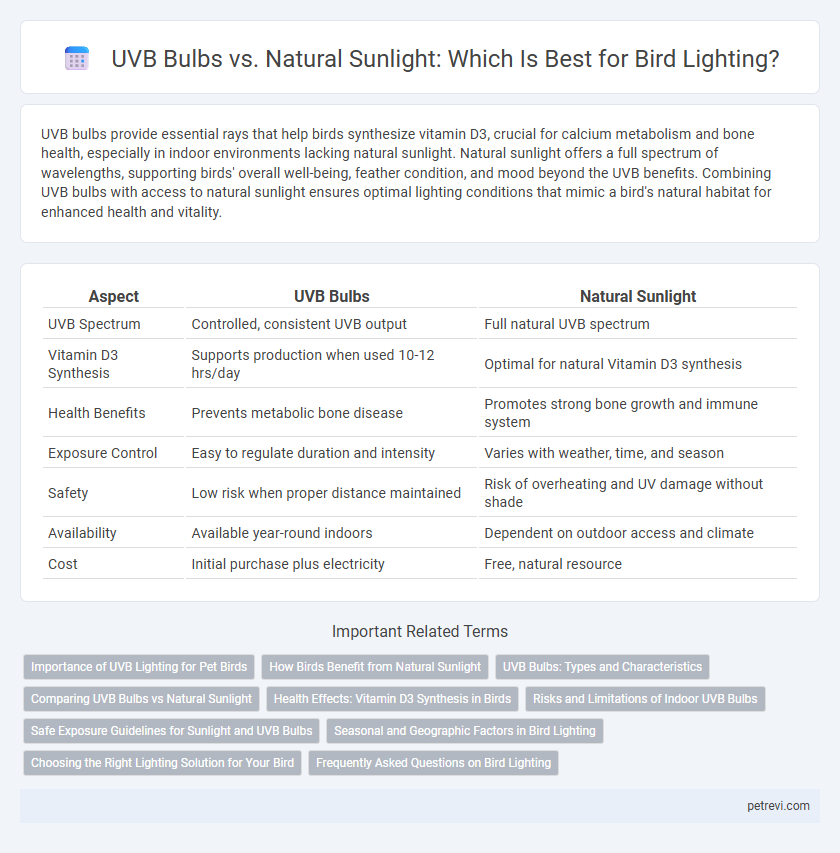UVB bulbs provide essential rays that help birds synthesize vitamin D3, crucial for calcium metabolism and bone health, especially in indoor environments lacking natural sunlight. Natural sunlight offers a full spectrum of wavelengths, supporting birds' overall well-being, feather condition, and mood beyond the UVB benefits. Combining UVB bulbs with access to natural sunlight ensures optimal lighting conditions that mimic a bird's natural habitat for enhanced health and vitality.
Table of Comparison
| Aspect | UVB Bulbs | Natural Sunlight |
|---|---|---|
| UVB Spectrum | Controlled, consistent UVB output | Full natural UVB spectrum |
| Vitamin D3 Synthesis | Supports production when used 10-12 hrs/day | Optimal for natural Vitamin D3 synthesis |
| Health Benefits | Prevents metabolic bone disease | Promotes strong bone growth and immune system |
| Exposure Control | Easy to regulate duration and intensity | Varies with weather, time, and season |
| Safety | Low risk when proper distance maintained | Risk of overheating and UV damage without shade |
| Availability | Available year-round indoors | Dependent on outdoor access and climate |
| Cost | Initial purchase plus electricity | Free, natural resource |
Importance of UVB Lighting for Pet Birds
UVB lighting is essential for pet birds as it enables the synthesis of vitamin D3, crucial for calcium absorption and bone health. Natural sunlight provides the full spectrum of UVB rays that promote vibrant plumage, strong immune function, and optimal metabolic processes. UVB bulbs designed for birds replicate these benefits indoors, ensuring consistent exposure when outdoor sunlight is unavailable.
How Birds Benefit from Natural Sunlight
Natural sunlight provides birds with a full spectrum of UVB rays essential for synthesizing vitamin D3, which supports calcium metabolism and bone health. Exposure to natural sunlight also enhances birds' immune systems and promotes natural behaviors by regulating their circadian rhythms. While UVB bulbs supplement these benefits, they cannot fully replicate the intensity and balanced spectrum of natural sunlight necessary for optimal avian health.
UVB Bulbs: Types and Characteristics
UVB bulbs for birds include fluorescent tubes, compact bulbs, and mercury vapor bulbs, each providing varying UVB output and heat levels essential for avian health. Fluorescent tubes offer stable UVB radiation with minimal heat, suitable for longer exposure, while compact bulbs deliver higher UVB intensity in a smaller form factor but generate more heat. Mercury vapor bulbs combine UVB radiation with natural heat, mimicking the sun's spectrum, improving vitamin D3 synthesis crucial for calcium metabolism and overall bird vitality.
Comparing UVB Bulbs vs Natural Sunlight
Natural sunlight provides birds with a full spectrum of UVB rays essential for vitamin D3 synthesis, promoting calcium metabolism and overall health. UVB bulbs offer a controlled alternative indoors but often lack the intensity and broad spectrum of natural sunlight, potentially limiting optimal UVB exposure. Consistent exposure to natural sunlight enhances feather coloration and behavioral well-being more effectively than most artificial UVB lighting solutions.
Health Effects: Vitamin D3 Synthesis in Birds
UVB bulbs provide a controlled source of ultraviolet light essential for Vitamin D3 synthesis in birds, directly impacting calcium absorption and bone health. Natural sunlight offers a broader spectrum of ultraviolet rays, promoting more efficient and balanced Vitamin D3 production along with overall well-being. Lack of sufficient UVB exposure, whether through bulbs or sunlight, can lead to metabolic bone disease and weakened immune response in avian species.
Risks and Limitations of Indoor UVB Bulbs
Indoor UVB bulbs for birds often fail to replicate the full spectrum and intensity of natural sunlight, limiting their effectiveness in promoting vitamin D3 synthesis. Prolonged exposure to artificial UVB light can cause eye damage, skin burns, and behavioral stress in birds due to improper intensity or placement. Unlike natural sunlight, UVB bulbs require careful monitoring and regular replacement to prevent health risks and ensure adequate exposure.
Safe Exposure Guidelines for Sunlight and UVB Bulbs
Safe exposure guidelines for bird lighting emphasize balanced UVB levels to prevent feather damage and skin burns. Natural sunlight offers a full spectrum of UV rays beneficial for vitamin D synthesis but requires limited, controlled exposure to avoid overheating and eye damage. UVB bulbs provide a consistent, safer alternative with measured emission, yet placement and timing must be carefully managed to replicate natural cycles without overexposure.
Seasonal and Geographic Factors in Bird Lighting
UVB bulbs provide consistent ultraviolet light for birds in regions or seasons with limited natural sunlight, supporting vitamin D synthesis essential for calcium metabolism and bone health. Natural sunlight remains superior in delivering a full spectrum of UV rays, but its availability varies significantly with geographic latitude and seasonal changes, often necessitating supplemental UVB lighting in winter or northern locations. Proper bird care integrates understanding these seasonal and geographic factors to optimize lighting conditions for avian health and wellbeing.
Choosing the Right Lighting Solution for Your Bird
Choosing the right lighting solution for your bird involves understanding the benefits of UVB bulbs versus natural sunlight. UVB bulbs provide a controlled source of ultraviolet light essential for vitamin D3 synthesis, calcium absorption, and overall health, especially in indoor environments where sunlight exposure is limited. Natural sunlight remains the most effective and complete source of UVB, promoting optimal feather condition, mood, and circadian rhythm regulation, but requires safe, supervised outdoor access to prevent overheating or predation risks.
Frequently Asked Questions on Bird Lighting
UVB bulbs provide consistent ultraviolet light crucial for vitamin D3 synthesis, preventing metabolic bone disease in birds. Natural sunlight offers a full spectrum of light essential for overall health but varies with weather and geographic location, making supplementation necessary in some indoor settings. Many bird owners ask if artificial UVB can fully replace sunlight; experts recommend combining both to ensure optimal calcium metabolism and feather quality.
UVB bulbs vs Natural sunlight for Bird lighting Infographic

 petrevi.com
petrevi.com